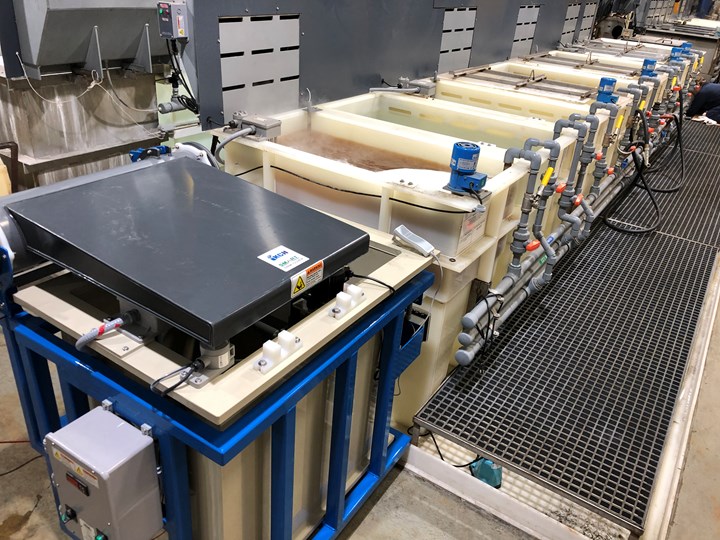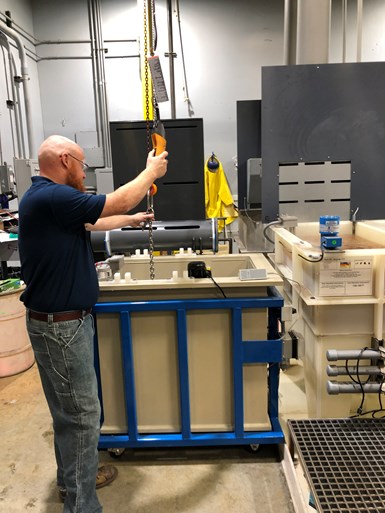Making Chrome Safe
A non-aqueous hard chrome alternative offers safe and environmentally sustainable functional and decorative chrome coatings.

SAFE Chrome is a different approach than that taken by traditional trivalent solutions. It uses an ionic liquid-based chemistry to reduce Cr3 to Cr0 in an easier way.
Photo Credit: Trion Coatings LLC
Trion Coatings LLC of South Bend, Indiana, is on a mission to provide the finishing industry with safe and environmentally sustainable functional and decorative chrome coatings that match the performance of hexavalent chromium-based solutions. The company believes it has the answer in a new, non-aqueous, trivalent chromium chemistry called SAFE Chrome.
Not to mix metaphors, but the quest to replace hexavalent chromium (also known as hex chrome or Cr6) has been both a sore subject and a bit of a holy grail for the finishing industry for decades. Widely used in coating systems for both decorative and functional applications, hex chrome offers excellent hardness, wear resistance, corrosion resistance and enhanced adhesion to substrates. However, hex chrome is proven to be carcinogenic and poses occupational and environmental hazards that has cost the industry hundreds of millions of dollars over decades. Compliance with increasingly stringent regulations has been a continuous struggle for plating operations and the future viable use of hex chrome continues to be a major concern for the metal finishing community.

SAFE Chrome meets standards for commercial specifications and functional applications while providing a safe operating environment for employees.
Photo Credit: Trion Coatings LLC
Many platers recall the year 2006, when OSHA lowered the Permissible Exposure Limit (PEL) for hexavalent chromium from 52 micrograms per cubic meter (µg/m3) to 5 micrograms per cubic meter (µg/m3). This widespread regulatory action occurred on the heels of previous ACGIH and NIOSH studies and recommendations.
Below are recent changes in recommended worker exposure limits to Hexavalent chromium:
- 2013 – The National Institute for Occupational Safety and Health (NIOSH) published a new Recommended Exposure Limit (REL) of 0.2 micrograms per cubic meter for hexavalent chromium to workers.
- 2018 - The American Conference of Governmental Industrial Hygienists (ACGIH) published a new Threshold Limit Value (TLV) of 0.2 micrograms per cubic meter for hexavalent chromium exposure to workers.
- 2022 and beyond – Will OSHA publish a change from its current PEL of 5 micrograms per cubic meter? History may suggest it is likely. A change to 0.2 micrograms per cubic meter would result in a 25 fold reduction from the current rule.
Trion set out to develop a trivalent chromium solution that checked all the boxes — safety, performance, cost. The company collaborated with several recognized industry partners including Nucor Steel, Imagineering Finishing Technologies, Surface Technology Inc., and KCH Surface Finishing.
“We’ve got a group of people who bring different skill sets to the table, and have been helping us guide the technology in its development now for more than 18 months,” says Doug Morrison, president and co-founder of Trion Coatings. “They were interested in doing the next type of chrome plating — something that perhaps gets the regulatory issues addressed.”
Trion says its SAFE Chrome trivalent chromium solution meets standards for commercial specifications and functional applications while also providing a safe operating environment for employees. It is RoHS (Restriction of Hazardous Substances) compliant, contains no Cr6 and is made without PFOA or PFOS, which is also emitted in the hex chrome process, and is its own source of regulatory scrutiny that has garnered significant attention from the EPA as it relates to its presence in myriad industries.
A bit of chemistry
SAFE Chrome is a different approach than that taken by traditional trivalent solutions. Morrison explains that traditional trivalent solutions are water-based chemistries that require additives that aid in reducing trivalent chrome to chrome metal. SAFE Chrome uses an ionic liquid-based chemistry to reduce Cr3 to Cr0 in an easier way.
With aqueous-based trivalent chemistries, the Cr3 ion is trapped inside of a highly stable bi-pyramidal complex. Because of this, the process of reducing the Cr3 in these systems causes hydrogen evolution at the cathode, which rapidly changes the pH of the solution. “You have all of these side reactions with all of these other components of that aqueous chemistry. So it's not just water in the Cr3, it's water, Cr3 and five other ingredients to disrupt that bi-pyramidal complex.”
SAFE Chrome’s ionic liquid chemistry simplifies things. Morrison explains, “We’ve got basically three ingredients water, ionic liquid and chrome. We only have to manage these three ingredients and the ionic liquids disrupt that water Cr3 ion complex. Because of that, we’re able to produce Cr3at lower voltages, and we’ve got less hydrogen evolution and less pH evolution.”
Total cost of ownership
One of the biggest concerns many finishing operations have regarding a switch to trivalent chromium is cost. Traditionally, switching from hexavalent to trivalent chromium was an expensive proposition for shops, and the sticker shock at the initial investment in new equipment and chemistry has been a deterrent for many finishers in the past. Trivalent chemistries have been evolving and chemical suppliers have been making strides toward making the total costs lower.
Trion Coatings set out to make switching to SAFE Chrome as easy a transition as possible. The solution is designed to use similar equipment often used in existing hexavalent chromium lines.
“From the beginning, we were committed to developing a technology that would be a drop-in replacement to the extent it could be,” says Morrison. “As a result, we now have a process that uses standard direct current rectification; uses no exotic materials; works without the use of hazardous lead anodes, works in open-air settings; and is an industrial compatible and robust technology. That’s been the mission from day one.”
He adds, “You may have to replace the liner of a tank, you may need to adjust the rectification size. But you’re still using direct current rectification. We’re not using pulse plating or things of that nature. Depending on the application and State requirements, there’s likely no need to change an existing exhaust system or racking.”
In addition to trying to keep the up-front investment in new equipment and chemistry as low cost as possible, Morrison says that the lifecycle costs of a plating line need to be taken into consideration when evaluating an investment in SAFE Chrome. This includes the cost of electricity, not just the capital equipment and the operational expenditure. SAFE Chrome’s increased plating rate allows it to provide build thickness more quickly and with a much lower cost of electricity to plate. In other words, the initial capital cost of the transition in terms of the investment in the chemistry and some adjustments in the equipment is quickly offset by a lower cost of operation.
“When you factor that in, your cost goes down significantly,” Morrison says. “Your total cost of ownership is lower, the plating rate is faster, and the efficiency is better.”
Another cost consideration to factor in is insurance coverage. As regulations continue to ramp up, an increasing number of finishing operations may find themselves having trouble finding liability insurance and workers’ compensation insurance that will cover operations that use hexavalent chromium.
“If you’re able to get hexavalent chromium out of your shop and not expose your workers to the risks associated with it, you’re going to be able to keep your premiums where they are — maybe reduce them,” Morrison says.
Performance
At the end of the day, the real question comes down to performance. A cost competitive solution offering environmental sustainability won’t replace a time-tested process if the coating itself doesn’t achieve the desired results.
Trion Coatings says SAFE Chrome can meet the specifications required of thin dense chrome (TDC). In terms of wear resistance, SAFE Chrome exceeds the AMS 2438 requirement. Taber Abrasion testing of the coating yielded sub 1.0 mass loss and the coating outperforms hexavalent chromium in Falex Pin and VeeBlock testing.
Further, the coating is ready for a wide range of functional applications from automotive to medical to construction and agriculture to aerospace and defense. In fact, Trion Coatings recently announced a Cooperative Research and Development Agreement (CRADA) with the U.S. Army Combat Capabilities Development Command Armaments Center (DEVCOM) to explore utilizing SAFE Chrome for defense applications.
Of course, when it comes to completely replacing hexavalent chromium there remains plenty of work ahead. Qualification of new materials for high performance applications such as aerospace is rigorous. Looking to transition trivalent chrome to an application such as aerospace landing gear is going to take time.
Finishers are working to educate regulatory committees such as CARB that set timetables for mandating a switch from hexavalent chrome to trivalent should be based on the specifications required of each application. That’s an important point for the evolution of trivalent chemistries. Perhaps rather than chasing our tails over a non-existent one-size-fits-all solution, thinking of trivalent chromium in terms of matching the right material to the right application is the best way to move forward.
Morrison says, “We have worked hard to develop and enhance our technology and we are now excited to be positioned to support the metal finishing industry transition away from hex chrome in a supportive way that will position those businesses for long-term safety and success.”
Want to learn more about Trion’s SAFE Chrome trivalent solution? Dig deeper in an episode of Products Finishing’s On the Line podcast. Visit short.pfonline.com/OTL15.
Related Content
Trivalent Chrome Overview
As the finishing industry begins to move away from the use of hexavalent chromium to trivalent chromium, what factors should finishers consider as they make new investments? Mark Schario, chief technology officer for Columbia Chemical offers a helpful overview of this complicated topic.
Read MorePossibilities From Electroplating 3D Printed Plastic Parts
Adding layers of nickel or copper to 3D printed polymer can impart desired properties such as electrical conductivity, EMI shielding, abrasion resistance and improved strength — approaching and even exceeding 3D printed metal, according to RePliForm.
Read MoreA Chromium Plating Overview
An overview of decorative and hard chromium electroplating processes.
Read MoreSuccessful South African Plater Beating the Odds
Remaining focused on quality and reliability, Team Plating Works stays profitable in a volatile and challenging economy.
Read MoreRead Next
Episode 5: Transitioning Hexavalent Chromium to Trivalent, Part 1
In this episode of On the Line, Products Finishing editor-in-chief Scott Francis sits down with Mark Schario, executive vice president with Columbia Chemical to hear about the latest innovations in trivalent chromium plating technology.
Read MoreEpisode 8: Considering Hex Chrome Alternatives
In this episode of On the Line, LumiShield CEO David Luebke and Senior Scientist John Watkins Ph.D. discuss the challenge of bringing alternative technologies to market.
Read MoreEducation Bringing Cleaning to Machining
Debuting new speakers and cleaning technology content during this half-day workshop co-located with IMTS 2024.
Read More






















